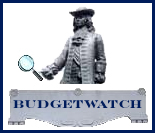- Home
- About
- News
- Tax Reform
- Ethics Reform
- Budget Reform
- Reformer’s Roundtable
- Contact Us







Crying Poor But Awash With Riches
 “At a time when our financial capacity to deliver quality City services is on the verge of being compromised, we are confronted with federal and state budgets that propose serious reductions in funding. Therefore, tax reductions, other than those proposed in my budget and Five Year Plan must be offset by new sources of revenue.” - Mayor John F. Street, Annual Address to the Greater
“At a time when our financial capacity to deliver quality City services is on the verge of being compromised, we are confronted with federal and state budgets that propose serious reductions in funding. Therefore, tax reductions, other than those proposed in my budget and Five Year Plan must be offset by new sources of revenue.” - Mayor John F. Street, Annual Address to the Greater
“Preliminary estimates show that the City will end FY 2006 with a $105.4 million operating surplus…bringing the projected year-end fund balance to $201.4 million”. - City of Philadelphia Quarterly City Managers Report, August 15, 2006
What a difference a few months makes. Just last year when the Mayor crafted the budget for the city’s fiscal year that just ended in June, he claimed the city was broke. Fire companies would have to be closed, libraries would be threatened, and additional tax cuts would jeopardize the ability of the city to provide services. But when the books were closed on the city’s 2006 Fiscal year at the end of June, it was clear that those dire predictions were unnecessary. The city found itself with almost $223 million more in tax revenue than was projected when the budget was approved, resulting in an end-of-year fund balance of more than $200 million — a far cry from broke.
The City of Philadelphia did not hit the lottery or strike oil deep in Fairmount Park. The windfall in revenues was the result of a significant underestimation of the tax revenues that would be collected in Fiscal Year 2006. The underestimation of city tax revenues was not by chance. In fact, the city administration routinely underestimates tax revenues each year to be cautious in its budgeting, but the underestimation also helps to disguise the city’s true fiscal picture to help thwart efforts to change mayoral budgetary priorities. The Mayor wants to spend how he wants to spend and disguising the true amount available to be spent helps turn away other requests for funding when the budget is being crafted. The Mayor can then use a back-door budget mechanism to use those extra funds later.
If the city administration had made more realistic estimates of tax-revenue collections, government leaders and the public could have engaged in a more productive discussion about how to allocate those funds. Instead of scare tactics from the city administration and threats of severe cuts to vital city services if anyone dared to change the mayor’s proposed budget, we could have had a reasonable discussion about the city’s priorities and our ability to fund the activities necessary to satisfy the needs of the citizenry.
Today, the city budget is used to document our government’s good intentions, reward political friends, and punish political foes — not to help address the needs of the citizenry, focus government on high performance, and improve the lives of Philadelphians. The underestimating of revenues to disguise the city’s true fiscal state is just one way our elected leaders use the budget process to help ensure that their priorities are funded while the citizenry’s priorities go unaddressed.
The choices made during the budget process provide the framework to guide the city’s activities in the coming year. Without reliable, accurate information about how much money will be available to support city service delivery, choosing what to fund in order to meet the needs of citizens is more difficult.
As for this year, the budget that was passed in the spring to cover Fiscal Year 2007, which will end in July of 2007, estimates that the city will generate $2.314 billion in tax revenues. However, in the fiscal year that just ended in June, the city generated $2.366 billion in tax revenues (these numbers are preliminary, and after adjustments, the final figure will likely be closer to $2.316 billion). Given inflation, salary increases, and the general state of the economy, it should be intuitively obvious to the casual observer that
